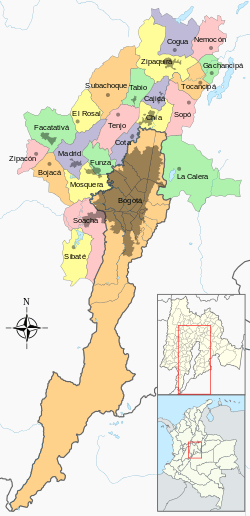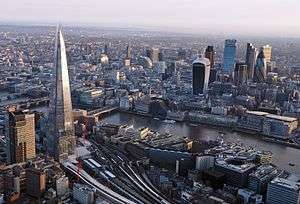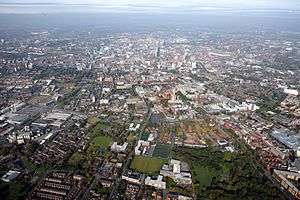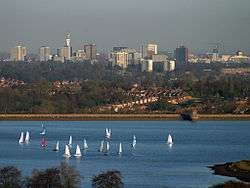Conurbation
| Population tables of world cities |
|---|
.jpg) |
A conurbation is a region comprising a number of cities, large towns, and other urban areas that, through population growth and physical expansion, have merged to form one continuous urban or industrially developed area. In most cases, a conurbation is a polycentric urbanised area, in which transportation has developed to link areas to create a single urban labour market or travel to work area.[1]
The term "conurbation" was coined in 1915 by Patrick Geddes in his book Cities In Evolution. He drew attention to the ability of the then new technology of electric power and motorised transport to allow cities to spread and agglomerate together, and gave as examples "Midlandton" in England, the Ruhr in Germany, Randstad in the Netherlands, New York City–North Jersey in the United States,[2] the Greater Tokyo Area, Taiheiyō Belt in Japan, NCR of Delhi in India, and Southern Metro Manila in the Philippines.
The term as described is used in Britain, whereas the term in the United States is most closely equivalent to "metropolitan area" as used by the Census Bureau. It may consist of a central city and its suburbs. A conurbation consists of adjacent metropolitan areas that are connected with one another by urbanization Internationally, the term "urban agglomeration" is often used to convey a similar meaning to "conurbation."[3] A conurbation should also be contrasted with a megalopolis, where the urban areas are close but not physically contiguous and where the merging of labour markets has not yet developed.
Africa
Mauritius
The cities and towns of Port Louis, Beau Bassin-Rose Hill, Curepipe, Quatre Bornes, Vacoas-Phoenix and other urbanized villages form a large and central conurbation on the island of Mauritius. A large part of this conurbation is located in the district of Plaines Wilhems. This network of urban areas has a total population of 530,920 (42.9% of the island's population) as of 2011.
Morocco
Nigeria
Lagos is a conurbation formed through the merged development of the initial Lagos city area with other cities and towns, such as Ikeja, Ojo, along with various suburban communities like Agege, Alimosho, Ifako-Ijaiye, Kosofe, Mushin, Oshodi and Shomolu.[5]
South Africa
Johannesburg, Ekurhuleni (East Rand), and Tshwane (greater Pretoria) are currently merging to form a region that comprises a population of 14.6 million people.[6]
Asia
China

Three conurbations in China are the Jingjinji comprising Tianjin, Beijing, Tangshan and Qinhuangdao; the Yangtze River Delta of Shanghai, Nanjing, Hangzhou and Ningbo; and the Pearl River Delta including Guangzhou, Shenzhen, Hong Kong and Macau.[7]
India
The Mumbai Metropolitan Region (MMR) consists of Mumbai and its satellite towns. Developing over a period of about 20 years, it consists of seven municipal corporations and fifteen smaller municipal councils. The region has an area of 4,355 km² and with a population of 20,998,395, and is among the top ten most populated urban agglomerations in the world. It is linked together through the Mumbai Suburban Railway system and a large network of roads.
The National Capital Region (NCR) is a name for the conurbation or metropolitan area which encompasses the entire National Capital Territory of Delhi as well as Gurgaon, Faridabad, Noida and Ghaziabad, which are urban areas ringing it in the neighbouring states of Uttar Pradesh, Haryana and Rajasthan. The population of the NCR region is 21.7 million.[8]
Bangladesh
Dhaka has recently been linked with Narayanganj and Gazipur city such that there are no gaps between Dhaka and those two cities.
Indonesia
Jakarta (19.6m)
Japan
The Taiheiyō Belt is the largest conurbation in Japan in every sense, extending from Ibaraki Prefecture to Fukuoka Prefecture, running almost 1,200 km, with the total population of 82.9 million. The Greater Tokyo Area, also called Shutoken (the National Capital Region), is a metropolitan area in the Kantō region, with the estimated population of 35,676,000 in 2007, often referred to as the most populous and economically largest metropolitan area in the world.
Malaysia
The Klang Valley conurbation in the state of Selangor is composed of:
- Kuala Lumpur, the capital of Malaysia;
- Petaling Jaya;
- Ampang Jaya;
- Pandan Indah;
- Subang Jaya;
- Klang;
- Selayang;
- Gombak and
- Kajang.
The second largest conurbation by population in Malaysia is Greater Penang. Centred in George Town, the capital city of the state of Penang, the conurbation also includes the following towns in Penang, and within the neighbouring states of Kedah and Perak.
- Bayan Lepas
- Balik Pulau
- Teluk Bahang
- Butterworth
- Bukit Mertajam
- Perai
- Nibong Tebal
- Kepala Batas
- Sungai Petani, Kedah
- Kulim, Kedah
- Bandar Baharu, Kedah
- Parit Buntar, Perak
The third largest conurbation by population in Malaysia is Iskandar Malaysia. Centred in Johor Bahru, the capital city of the state of Johor, the conurbation also includes the following towns in Johor that composed of:
- Johor Bahru, the centre of Iskandar Malaysia
- Tebrau
- Pasir Gudang
- Ulu Tiram
- Kempas
- Tampoi
- Skudai
- Iskandar Puteri
- Senai
- Kulai
- Pekan Nenas
Pakistan
- Karachi Metropolitan Area is one of the largest metropolitan areas of the world, with a population exceeding 25 million (2014).
- Rawalpindi–Islamabad, also known as the twin cities of Pakistan, were built about 8 miles apart and have now completely intertwined into each other due to massive population growth and the expansion of both cities.
- Lahore–Raiwind–Kala Shah Kaku, the second largest city in Pakistan with its adjoining towns of Kala Shah Kaku and Raiwind.
Philippines
Metro Manila, Philippines (21m)
Thailand
Bangkok Metropolitan Region, Thailand (14m)
Vietnam
- Ho Chi Minh City Metropolitan Region: comprising Ho Chi Minh City (itself comprising Saigon, Cholon, Gia Định, Thu Đức, Nhà Bè, Bình Chánh, Hóc Môn and Củ Chi); Bình Dương (itself comprising Thủ Dầu Một, Thuận An and Dĩ An); Đồng Nai (itself comprising Biên Hòa and Long Thành); Bà Rịa–Vũng Tàu (itself comprising Vũng Tàu, Bà Rịa, Phu My and Long Hải); Tây Ninh; and Tân An.
- Hanoi Metropolitan Region: comprising Hanoi (itself comprising Hanoi, Gia Lâm, Đông Anh, Mê Linh, Hà Đông, Hoai Đức and Sơn Tây); Bắc Ninh (itself comprising Từ Sơn and Bắc Ninh); Thái Nguyên; Vĩnh Phúc (itself comprising Phúc Yên and Vĩnh Yên); and Việt Trì.
- Qui Nhơn-Nha Trang-Da Lat Conurbation Belt: comprising Qui Nhơn, An Nhơn, Sông Cầu, Tuy Hòa, Vân Phong Bay, Ninh Hòa, Nha Trang, Dien Khánh, Cam Lâm, Cam Ranh, Trường Sa, Phan Rang, and Da Lat.
- Huế-Da Nang-Quảng Ngãi Conurbation Belt: comprising Huế, Hương Tra, Hương Thủy, Lăng Cô, Da Nang, Hòa Vang, Hoàng Sa, Hội An, Tam Kỳ, Chu Lai, Dung Quất, Sơn Tịnh, and Quảng Ngãi.
Caribbean
Puerto Rico
The Caribbean area, which is generally not considered to be part of a continent geographically speaking, has a small conurbation in Puerto Rico consisting of San Juan, Bayamon, Guaynabo, Carolina, Canovanas, Caguas and Catano. This area is colloquially known as the "Area Metropolitana".
Europe
Belgium
The Flemish Diamond (Dutch: Vlaamse Ruit) is the Flemish reference to a network of four metropolitan areas in Belgium, three of which are in the central provinces of Flanders, together with the Brussels Capital Region. It consists of four agglomerations which form the four corners of a diamond shape: Brussels, Ghent, Antwerp and Leuven. Over five million people live in this conurbation, with a population density of more than 800 per square kilometre.
France
The most notable conurbation is Lille-Roubaix-Tourcoing-Villeneuve-d'Ascq, located in the north of France, with over 1.2 million people living in the area.[9]
Germany

Germany has three conurbations along the River Rhine, namely Rhine-Main, Rhine-Neckar and Rhine-Ruhr. The Rhine-Ruhr is the largest conurbation in continental Europe and is a densely populated polycentric metropolitan region in the western part of Germany, comprising the three subregions of Ruhr Metropolitan Region, Düsseldorf-Mönchengladbach-Wuppertal Region and Cologne/Bonn Metropolitan Region. These three are all interlinked by a continuous urban settlement, while at the same time having cultural and economic differences.
Malta
Valletta Urban Area, the area around the Grand Harbour, is the main conurbation in Malta. It contains 27 of the Malta's 68 local councils including the capital Valletta. According to the Demographia, Valletta Urban Area has a population of 300,000,[10] while the European Spatial Planning Observation Network states that the functional urban area of Valletta has a population of 355,000,[11] which represents about 75% of Malta's population.
Netherlands
The Randstad is a densely populated area in the Netherlands with over 7 million inhabitants. It consists of a cluster of the four biggest cities of the country (Amsterdam, Rotterdam, The Hague and Utrecht) as well as several smaller cities, towns and urbanized villages.
Poland
Katowice Urban Area (aglomeracja katowicka', konurbacja górnośląska, GOP) is the largest conurbation in Poland, located in Upper Silesia, southern Poland. Around 2.5 million people live in the region — up 5.26% of the population of Poland.
Spain
United Kingdom
Industrial and housing growth in the United Kingdom during the 19th and early 20th centuries produced many conurbations. Greater London is by far the largest urban area and is usually counted as a conurbation in statistical terms, but differs from the others in the degree to which it is focused on a single central area. In the mid-1950s the Green Belt was introduced to stem the further urbanisation of the countryside in England.
The list below shows the most populous urban areas in the UK as defined by the Office for National Statistics (ONS). The Greater London Urban Area contains the whole of what is commonly called London, but ONS definitions divide London into a large number of smaller localities of which the largest is Croydon.
- Important Note: This lists UK urban areas only and excludes UK conurbations by definition of the term. As used in the UK, the term "conurbation" is closer to the meaning of urban agglomeration. For example, the Liverpool–Manchester or the Manchester–Liverpool conurbation [12] is defined as one conurbation by AESOP in a comparison report published by the University of Manchester in 2005 found here. The Liverpool–Manchester Conurbation has a population of 5.68 million.
North America
Canada
Golden Horseshoe (Ontario)
The "Golden Horseshoe" is a densely populated and industrialized region centred on the west end of Lake Ontario in Southern Ontario, Canada. Most of it is also part of the Windsor-Quebec City corridor. With a population of 8.8 million people, the Golden Horseshoe makes up slightly over a quarter (25.6%) of the population of Canada and contains approximately 75% of Ontario's population,[16] making it one of the largest population concentrations in North America. Although it is a geographically named sub-region of Southern Ontario, "Greater Golden Horseshoe" is more frequently used today to describe the metropolitan regions that stretch across the area in totality. The largest cities in the region include Toronto, Mississauga, Oakville, Burlington, St. Catherines, Brampton, and Hamilton.[17]
Greater Montreal (Quebec)
Greater Montreal is Canada's 2nd largest conurbation, with Statistics Canada defining the Census Metropolitan Area (CMA) as 4,258.31 square kilometres (1,644.14 sq mi) and a population of 3,824,221 as of 2011, which represents almost half of the population of the province of Quebec. Slightly smaller, there are 82 municipalities grouped under the Montreal Metropolitan Community to coordinate issues such as land planning, transportation, and economic development.
Lower Mainland (British Columbia)
British Columbia's Lower Mainland is the most populated area in Western Canada. It consists of many mid-sized contiguous urban areas, including Vancouver, North Vancouver (city and district municipality), Surrey, Burnaby, Richmond, and Coquitlam. The Lower Mainland population is around 2.5 million (as of 2011) and the area has one of the highest growth rates on the continent of up to 9.2 percent from the 2006 census.
National Capital Region (Ontario and Quebec)
The National Capital Region (NCR) is made up of the capital, Ottawa, and neighbouring Gatineau which is located across the Ottawa River. As Ottawa is in Ontario and Gatineau, Quebec, this is a unique conurbation. Federal government buildings are located in both cities and many workers live in one city and work in the other. The National Capital Region consists of an area of 5,319 square kilometres that straddles the boundary between the provinces of Ontario and Quebec. The area of the National Capital Region is very similar to that of the Ottawa-Gatineau Census Metropolitan Area (CMA), although the National Capital Region contains a number of small neighbouring communities that are not contained within the CMA. When all the communities are added, the population is around 1,500,000. Ottawa-Gatineau is the only CMA in the nation to fall within two provinces.
United States

New York Tri-state area
One example of a conurbation is the expansive concept of the New York metropolitan area (the Tri-state region) centered on New York City, including 30 counties spread between New York State, New Jersey, Connecticut, and Pennsylvania, with an estimated population of 21,961,994 in 2007.[18] Approximately one-fifteenth of all U.S. residents live in the Greater New York City area. This conurbation is the result of several central cities whose urban areas have merged.
Greater Boston Area
Holding a population of 7,427,336 as of 2005, the Combined Statistical Area including Greater Boston consists of Boston proper and a collection of distinct but intertwined cities including Providence, Rhode Island, Worcester, Massachusetts, and Manchester, New Hampshire. Most importantly, the cities that comprise the Greater Boston CSA are interlinked by heavy public transportation infrastructure, maintain continuously urban interstices, and hold mutual commuting patterns.
San Francisco Bay Area
Another conurbation is the combination of the metropolitan areas of San Francisco, Oakland, and San Jose and several minor urban centers, known as the San Francisco Bay Area.
Greater Los Angeles Area
The Greater Los Angeles Area consists of the merging of several distinct central cities and counties, including Los Angeles, Orange County, Riverside, and San Bernardino. This area is also often referred to simply as Southern California or colloquially as SoCal (a larger region which tends to include San Diego).
Baltimore–Washington Area
The traditionally separate metropolitan areas of Baltimore and Washington, D.C. have shared suburbs and a continuous urbanization between the two central cities (Baltimore–Washington metropolitan area).
San Diego–Tijuana
The largest conurbation between the United States and Mexico, San Diego–Tijuana includes the two countries' busiest border crossing and a shared economy.[19]
Dallas—Fort Worth
Three large cities, Dallas, Fort Worth, and Arlington, make up this area. Each city is linked by touching city limits or suburbs. This area is also commonly known as the Metroplex and is included in the emerging megalopolis known as the Texas Triangle.
Detroit–Windsor
The major U.S. city of Detroit, Michigan lies immediately across the Detroit River from Windsor, Ontario in Canada. In many respects—economically, historically, culturally, socially, and, of course, geographically—Windsor is more a part of Metro Detroit than of Ontario. The two cities and their surrounding suburbs are commonly referred to collectively as the Detroit–Windsor area. The Detroit-Windsor border is the largest commercial border crossing in North America and the busiest between the two countries.[20] With a combined total population of nearly six million, Detroit-Windsor is the world's largest trans-border metropolitan area (since Hong Kong was returned to China.)
South Florida
The entire tri-county area also known as the Miami-Fort Lauderdale-West Palm Beach metropolitan area is now continuously urbanized along a roughly 100 miles (161 km) length of the Florida east coast as well as extending inland and continuing south of Miami as far as Florida City. Although this is generally all referred to as a single metropolitan area, not a conurbation, it is sometimes broken up into the Miami, Fort Lauderdale, and West Palm Beach metros.
St. Paul – Minneapolis
Minneapolis–Saint Paul is the most populous urban area in the state of Minnesota, and is composed of 182 cities and townships built around the Mississippi, Minnesota, and St. Croix rivers. The area is also nicknamed the Twin Cities for its two largest cities, Minneapolis, with the highest population, and Saint Paul, the state capital.
The Valley of the Sun
Phoenix, Arizona is the capital and most populous city in Arizona. It is the center of The Valley of the Sun, recognized by the United States Census Bureau as Chandler, Mesa, and Phoenix in the MSA. Other communities in the metropolitan area include Scottsdale, Glendale, Tempe, Gilbert, and Peoria.
Oceania
Australia
- South-East Queensland
A built-up area 200 kilometres long,[21] centred on Brisbane, includes the local government areas (LGAs) of Gold Coast, Ipswich, Logan City, Moreton Bay, Redland City, Sunshine Coast and Tweed Heads, New South Wales. This area is served by a single public transport network, Translink.
Broader definitions of South East Queensland are also used, including the separate built-up area of Toowoomba (140 kilometres; 87 miles west of Brisbane), which is not part of the Translink network. Expansive definitions of South East Queensland give it a population of more than 3.4 million people (2014),[22] covers 22,420 square kilometres (8,660 sq mi), incorporates ten LGAs and extends 240 kilometres (150 mi) from Noosa in the north to the Gold Coast (some sources include Tweed Heads).
- Greater Perth
The Perth Metropolitan Region, City of Mandurah and Pinjarra comprise a continuous urban area in Western Australia more than 130 km (80 miles) long, on a north-south axis – which is sometimes known as "Greater Perth" – and has a population of more than 2.05 million (2015).[23] Introduction of the Mandurah railway line in 2007 made it possible for commuters to travel the 70 km (43.5 mi) from Mandurah station to Perth station in 48 minutes.
- Canberra-Queanbeyan
A cross border built-up area compromising of the nation's capital Canberra in the Australian Capital Territory and the city of Queanbeyan in New South Wales, which is considered by the Australian Bureau of Statistics to have a single labour market[24].
New Zealand
In 2010 Auckland became a unitary authority encompassing seven former city and district councils including Auckland City, Waitakere City, North Shore City and Manukau City as well as a number of smaller towns, rural area and the islands of the Hauraki Gulf. Auckland is the largest council in Australasia and the region has a population of 1,529,300, being almost 33% of the total population of New Zealand.
The Wellington metropolitan area compromises the four cities of Wellington City, Porirua and the cities of Lower Hutt and Upper Hutt, together known as Hutt Valley. The Wellington metropolitan area, is the second largest Urban population in New Zealand with a population of 409,200.
South America
There are 4 conurbations of at least 10 million people in South America, with at least one more soon to reach that population.
Argentina
| Conurbation | Population | Year | Note | |
|---|---|---|---|---|
 | Greater Buenos Aires | 13,641,973[25] | 2010 | Metro region excluding La Plata and its metro area (an additional 694,253 [ INDEC ]). |
- Greater Buenos Aires (12.046.799) – Greater La Plata (694.253) – Zárate / Campana
Brazil
The entire Rio–São Paulo area is also sometimes considered a conurbation, and plans are in the works to connect the cities with a high-speed rail. Yet the government of Brazil does not consider this area a single unit for statistical purposes, and population data may not be reliable.
| Conurbation | Population | Year | Note | |
|---|---|---|---|---|
 | RM Rio de Janeiro | 12,330,186[26] | 2016 | Metropolitan region. |
 | CME São Paulo | 27,640,577[27] | 2009 | The CME of São Paulo is federally defined as the São Paulo Metro region (RMSP) and its conurbations. |
Colombia
| Conurbation | Population | Year | Note | |
|---|---|---|---|---|
 | Metropolitan Area of Bogotá | 10,733,206[28] | 2014 | Conurbation only between Bogota and Soacha |
 | Metropolitan Area of the Aburrá Valley | 3,821,797[28] | 2014 | Metro region |
Peru
| Lima and Callao Metropolitan Area | 9,367,587[29] | 2011 | Lima is expected to become a megacity before the end of the decade, and this conurbation is estimated to have grown by over 800,000 people between 2007 and 2011. |
See also
| Look up conurbation in Wiktionary, the free dictionary. |
- Amalgamation (politics)
- Combined Statistical Area
- Consolidated city-county
- Ecumenopolis
- Ekistics
- Globalization
- List of metropolitan areas by population
- Largest cities of the world
- Megacity
- Megalopolis
- Metropolis
- Suburbs
- The Sprawl
- Transborder agglomeration
- Urban sprawl
- Urban agglomeration
References
- ↑ conurbation Dictionary Definition of conurbation Encyclopedia.com
- ↑ Hall, Peter (2002). Cities of Tomorrow. ISBN 0-631-23252-4.
- ↑ Vision of Britain article on use of this and similar terms
- ↑ Sale – the free dictionary
- ↑ Lagos is wonderful and charming conurbation of Nigeria to visit by Charles Caprio
- ↑ Baker, Deane-Parker (15 September 2010). "South Africa's threat environment: a guide for the National Planning Commission". African Security Review. Pretoria: Routledge. 19 (3): 54–64. ISSN 1024-6029. doi:10.1080/10246029.2010.519878. Retrieved 9 May 2011.
...what military force would relish tackling Johannesburg, Ekurhuleni (the East Rand) and Tshwane (greater Pretoria), which will by 2015 be a single polycentric urban region...
- ↑ Williams, Alan (2009). Contemporary Issues Shaping China's Civil Aviation Policy: Balancing International With Domestic Priorities. Burlington, Vermont: Ashgate Publishing Company. p. 34. ISBN 978-0-7546-9183-9.
- ↑ http://timesofindia.indiatimes.com/city/delhi/NCR-population-shot-up-by-40-in-10-years/articleshow/10422968.cms
- ↑ https://books.google.fr/books?id=qYvMixiCinYC&pg=PA1828&dq=lille+roubaix+tourcoing&hl=fr&sa=X&ved=0ahUKEwip5b-quaHMAhUouoMKHYvFBiQ4FBDoAQhMMAk#v=onepage&q=lille%20roubaix%20tourcoing&f=false
- ↑ World Urban Areas – Demographia, 2014
- ↑ Study on Urban Functions – European Spatial Planning Observation Network, 2007
- ↑ Schulze Bäing, Andreas. "Shrinking cities and growing regions – emerging trends of new rural-urban relationships in the UK and Germany". 13 July. AESOP University of Manchester. Retrieved 19 March 2015.
- ↑ "2011 Census - Built-up areas". ONS. Retrieved 1 July 2013.
- ↑ Mid-2012 Population Estimates for Settlements and Localities in Scotland General Register Office for Scotland
- ↑ The UK's major urban areas Office for National Statistics (Urban area of Belfast and connected settlements, Table 3.1, page 47)
- ↑ "Portrait of the Canadian Population in 2006: Sub-provincial population dynamics, Greater Golden Horseshoe". Statistics Canada, 2006 Census of Population. 2007-03-13. Retrieved 2007-03-13.
- ↑ "Places to Grow Act, 2005". Government of Ontario. Retrieved 2012-07-25.
- ↑ "Annual Estimates of the Population of Combined Statistical Areas: April 1, 2000 to July 1, 2007" (CSV). 2007 Population Estimates. United States Census Bureau, Population Division. 2008-03-27. Retrieved 2008-05-26.
- ↑ Loucky, James (ed.). Transboundary policy challenges in the Pacific border regions of North America. University of Calgary Press. p. 8. ISBN 1-55238-223-0. Retrieved February 19, 2011.
- ↑ The Canada-U.S. border: by the numbers – Canada – CBC News. Cbc.ca (2011-12-07). Retrieved on 2013-07-16.
- ↑ http://www.brisbanetimes.com.au/queensland/seqs-200kilometre-urban-sprawl-prediction-comes-true-planning-expert-20150622-ghuqak.html
- ↑ "3218.0 - Regional Population Growth, Australia, 2013-14". Australian Bureau of Statistics. ERP at 30 June 2014.
- ↑ http://www.abs.gov.au/ausstats/abs@.nsf/mf/3218.0
- ↑ http://abs.gov.au/ausstats/abs@.nsf/Latestproducts/1216.0.55.003Main%20Features3May%202010?opendocument&tabname=Summary&prodno=1216.0.55.003&issue=May%202010&num=&view=
- ↑ Greater Buenos Aires – 2010 Census provisional results
- ↑ http://www.ibge.gov.br/home/estatistica/populacao/estimativa2016/estimativa_dou.shtm
- ↑ http://www.ibge.gov.br/home/estatistica/populacao/estimativa2009/POP2009_DOU.pdf
- 1 2 "DANE". Archived from the original on 13 November 2009. Retrieved 25 December 2014.
- ↑ – The population listed in the text on this page is an estimate from 2005 data, which has been replaced by the 2007 Census on the site
Further reading
- Patrick Geddes – "Cities In Evolution"
- Edward Soja – "Postmetropolis"



